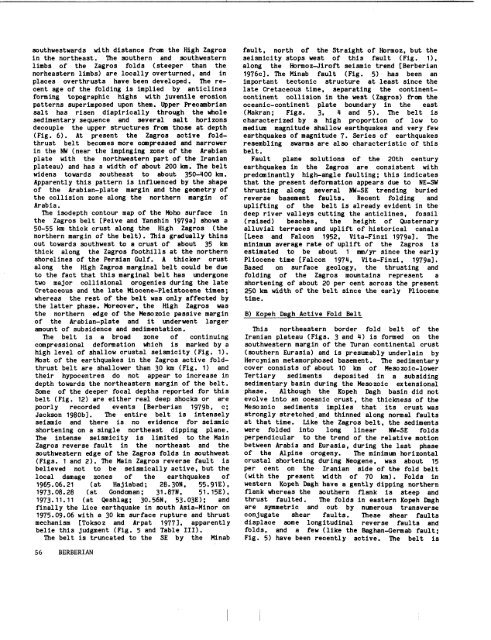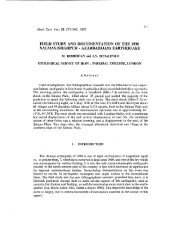PDF COPY - Manuel berberian
PDF COPY - Manuel berberian
PDF COPY - Manuel berberian
You also want an ePaper? Increase the reach of your titles
YUMPU automatically turns print PDFs into web optimized ePapers that Google loves.
southwestwards with distance from the High Zagros<br />
in the northeast. The southern and southwestern<br />
limbs of the Zagros folds (steeper than the<br />
norheastern limbs) are locally overturned, and in<br />
places overthrusts have been developed. The recent<br />
age of the folding is implied by anticlines<br />
forming topographic highs with Juvenile erosion<br />
patterns superimposed upon them. Upper Precambrian<br />
salt has risen dlaplrlcally through the whole<br />
sedimentary sequence and several salt. horizons<br />
decouple the upper structures from those at depth<br />
(Fig. 6). At present the Zagros active foldthrust<br />
belt becomes more compressed and narrower<br />
in the NW (near the impinging zone of the Arabian<br />
plate with the northwestern pert of the Iranian<br />
plateau) and has a width of about 200 km. The belt<br />
widens towards southeast to about 350-400 km.<br />
Apparently this pattern is influenced by the shape<br />
of the Arabian-plate margin and the geometry of<br />
the collision zone along the northern margin of<br />
Arabia.<br />
The isodepth contour map of the ~oho surface in<br />
the Zagros belt [Peive and Yanshin 1979a] shows a<br />
50-55 km thick crust along the High Zagros (the<br />
northern margin of the belt). This gradually thins<br />
out towards southwest to a crust of about 35 km<br />
thick along the Zagros foothills at the northern<br />
shorelines of the Persian Gulf. A thicker crust<br />
along the High Zagros marginal belt could be due<br />
to the fact that this marginal belt has undergone<br />
two major collislonal orogenies during the late<br />
Cretaceous and the late Miocene-Pleistocene times;<br />
whereas the rest of the belt was only affected by<br />
the latter phase. Moreover, the High Zagros was<br />
the northern edge of the Mesozoic passive margin<br />
of the Arabian-plate and it underwent larger<br />
amount of subsidence and sedimentation.<br />
The belt is a broad zone of continuing<br />
compresslonal deformation which is marked by a<br />
high level of shallow crustal seismicity (Fig. I).<br />
Most of the earthquakes in the Zagros active foldthrust<br />
belt are shallower than 30 km (Fig. I) and<br />
their hypocentres do not appear to increase in<br />
depth ~owards the northeastern margin of the belt.<br />
Some of the deeper focal depths reported for this<br />
belt (Fig. 12) are either real deep shocks or are<br />
poorly recorded events [Berberian 1979b, c;<br />
Jackson 1980b]. The entire belt is intensely<br />
seismic and there is no evidence for seismic<br />
shortening on a single northeast dipping plane.<br />
The intense selsmlcity is limited to the Main<br />
Zagros reverse fault in the northeast and the<br />
southwestern edge of the Zagros folds in southwest<br />
(Figs. I and 2). The Main Zagros reverse fault<br />
believed not to be seismically active, but the<br />
local damage zones of the earthquakes of<br />
1965.06.21 (at HaJiabad; 28.30N, 55.91E),<br />
1973.08.28 (at Gondoman; 31.87N, 51.15E),<br />
1973.11.11 (at Oeshlag; 30.56N, 53.03E); and<br />
finally the Lice earthquake in south Asia-Minor on<br />
1975.09.06 with a 30 km surface rupture and thrust<br />
mechanism [Toksoz and Arpat 1977], apparently<br />
belie this Judgment (F18. 5 and Table III).<br />
The belt is truncated to the SE by the Minab<br />
fault, north of the Straight of Hormoz, but the<br />
selsmicity stops west of this fault (Fig. I),<br />
along the Hormoz-Jiroft seismic trend [Berberian<br />
1976c]. The Minab fault (Fig. 5) has been<br />
important tectonic structure at least since the<br />
late Cretaceous time, separating the continentcontinent<br />
collision in the west (Zagros) from the<br />
oceanic-continent plate boundary in the east<br />
(Makran; Figs. 3, 4 and 5). The belt<br />
characterized by a high proportion of low to<br />
medium magnitude shallow earthquakes and very few<br />
earthquakes of magnitude . Series of earthquakes<br />
resembling swarms are also characteristic of this<br />
belt.<br />
Fault plane solutions of the 20th century<br />
earthquakes in the Zagros are consistent with<br />
predominantly high-angle faulting; this indicates<br />
that the present deformation appears due to NE-SW<br />
thrusting along several NW-SE trending buried<br />
reverse basement faults. Recent folding and<br />
uplifting of the belt is already evident in the<br />
deep river valleys cutting the anticlines, fossil<br />
(raised) beaches, the height of Quaternary<br />
alluvial terraces and uplift of historical canals<br />
[Lees and Falcon 1952, Vita-Finzi 1979a]. The<br />
minimom average rate of uplift of the Zagros is<br />
estimated to be about I mm/yr since the early<br />
Pliocene time [Falcon 1974, Vlta-Finzl, 1979a].<br />
Based on surface geology, the thrusting and<br />
folding of the Zagros mountains represent a<br />
shortening of about 20 per cent across the present<br />
250 km width of the belt since the early Pliocene<br />
time.<br />
B) Kopeh Dash Active Fold Belt<br />
This northeastern border fold belt of the<br />
Iranian plateau (Figs. 3 and 4) is formed on the<br />
southwestern margin of the Turan continental crust<br />
(southern Eurasia) and is presumably underlain<br />
Hercynian metamorphosed basement. The sedimentary<br />
cover consists of about 10 km of Mesozolc-lower<br />
Tertiary sediments deposited in a subsiding<br />
sedimentary basin during the Mesozoic extensional<br />
phase. Although the Kopeh Dagh basin did not<br />
evolve into an oceanic crust, the thickness of the<br />
Mesozoic sediments implies that its crust was<br />
strongly stretched.and thinned along normal faults<br />
at that time. Like the Zagros belt, the sediments<br />
were folded into long linear NW-SE folds<br />
perpendicular to the trend of the relative motion<br />
between Arabia and Eurasia, during the last phase<br />
of the Alpine orogeny. The minimum horizontal<br />
crustal shortening during Neogene, was about 15<br />
per cent on the Iranian side of the fold belt<br />
(with the present width of 70 km). Folds<br />
western Kopeh Dagh have a gently dipping northern<br />
flank whereas the southern flank is steep and<br />
thrust faulted. The folds in eastern Kopeh Dagh<br />
are symmetric and cut by numerous transverse<br />
conjugate shear faults. These shear faults<br />
displace some longitudinal reverse faults and<br />
folds, and a few (like the Baghan-Germab fault;<br />
Fig. 5) have been recently active. The belt is<br />
56 BERBERIAN<br />
I i







